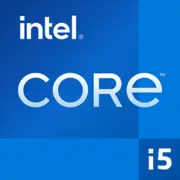Intel Core i5-1250P

Intel Core i5-1250P: Analysis of a Mobile Processor for Hybrid Tasks
March 2025
Several years have passed since the release of Intel's Alder Lake processors, but models like the Core i5-1250P remain popular in budget and mid-range laptops. Let’s explore how relevant this chip is in 2025, who it suits, and how it performs in real scenarios.
Architecture and Process Technology: Hybrid Approach and Intel 7
The Intel Core i5-1250P is built on the hybrid Alder Lake architecture, which combines high-performance P-cores (Performance) and energy-efficient E-cores (Efficiency).
- Cores and Threads: 12 cores (4P + 8E) and 16 threads. P-cores operate at frequencies up to 4.4 GHz in turbo mode, while E-cores reach up to 3.3 GHz.
- Cache: 12 MB L3.
- Process Technology: Intel 7 (10nm Enhanced SuperFin).
- Integrated Graphics: Iris Xe with 80 EU (Execution Units), supporting DirectX 12, AV1 decoding, and HDMI 2.1.
The hybrid architecture optimizes task distribution: P-cores handle heavy applications (like rendering), while E-cores take care of background processes (updates, streaming). Intel Thread Director manages the load in real time, which is particularly useful in Windows 11.
Power Consumption and TDP: Balancing Power and Battery Life
The nominal TDP of the i5-1250P is 28W, but in turbo mode, it can reach up to 64W. This puts a strain on the cooling system, especially in thin laptops.
- Operating Modes:
- PL1 (long-term load): 28W.
- PL2 (short-term boost): 64W (up to 28 seconds).
- Power-saving Technologies:
- Intel Dynamic Tuning 2.0: adaptively adjusts power based on load.
- Speed Shift: instant switching between P-states to reduce latency.
In practice, in ultrabooks (e.g., ASUS ZenBook 14), the processor often runs in the 15-25W range to minimize heat generation.
Performance: From Office to Gaming
Office Tasks
- PCMark 10 Tests: 5200–5400 points.
- Launching 20 tabs in Chrome + Excel: no lags.
- PDF conversion: 15% faster than the i5-1135G7.
Multimedia
- HandBrake (4K → 1080p): 22 minutes (compared to 28 minutes for Ryzen 5 5625U).
- Adobe Photoshop (Neural Filters): Iris Xe speeds up AI filters by 30% thanks to DP4a support.
Gaming
- CS2 (1080p, low settings): 45-60 FPS.
- The Sims 4 (1080p, medium): 60 FPS.
- Cyberpunk 2077 (720p, FSR): 25-30 FPS – playable, but only for less demanding scenarios.
Turbo Mode: Under short-term load (like launching a game), P-cores boost to 4.4 GHz, but after 30-40 seconds, the frequency drops to 3.8-4.0 GHz due to heating.
Use Cases: Who is the i5-1250P Suitable For?
- Students and Office Workers: Multitasking (Zoom + browser + documents) without slowdowns.
- Freelancers: Photo/video editing in Lightroom or Premiere Pro (for 1080p).
- Casual Gamers: Playing titles like Dota 2 or Fortnite on low settings.
- Travelers: Adequate performance with a laptop weight starting from 1.2 kg.
Not Suitable For:
- Professional 3D designers (too few cores for rendering).
- Streamers (insufficient power for simultaneous gaming and video encoding).
Battery Life: How Long Will the Battery Last?
In laptops with a 60–70 Wh battery (e.g., Lenovo ThinkPad T14):
- Office Mode (brightness 150 nits): 8–10 hours.
- YouTube Streaming (1080p): 6–7 hours.
- Heavy Load (rendering): 1.5–2 hours.
Power-saving Technologies:
- Display Power Saving: automatically lowers GPU frequency when displaying static images.
- Connected Standby: background data synchronization during sleep mode.
Tip: Disable Turbo Boost in power settings to extend battery life by 20–25%.
Comparison with Competitors
AMD Ryzen 5 7640U (Zen 4, 4nm):
- Pros: Better power efficiency (up to 12 hours for office tasks).
- Cons: Weaker in single-threaded tasks (Geekbench 6 Single: 1890).
Apple M2 (5nm):
- Pros: Video editing in Final Cut Pro is 30% faster.
- Cons: Limited compatibility with Windows programs.
Intel Core i7-1260P:
- Pros: +2 P-cores, higher performance in multi-threaded tasks.
- Cons: Pricing of laptops is $200–300 higher.
Pros and Cons of the Core i5-1250P
Strengths:
1. Excellent single-thread performance (Geekbench 6 Single: 2077).
2. Supports Thunderbolt 4 and Wi-Fi 6E.
3. Affordable laptop prices (starting at $800).
Weaknesses:
1. Heating in thin cases (e.g., Acer Swift 3).
2. Dependence on the quality of the cooling system.
3. Lags behind Ryzen 7 in multi-threaded workloads.
Laptop Selection Recommendations
- Type of Device: Ultrabooks (Dell XPS 13, HP Spectre x360) or business laptops (Lenovo ThinkPad T14s).
- What to Look For:
- Cooling: 2 fans + heat pipes.
- Screen: Brightness from 300 nits, FHD/IPS resolution.
- Battery: At least 50 Wh.
- Examples of 2025 Models:
- ASUS Vivobook S14: $899, 16 GB RAM, 1 TB SSD.
- MSI Modern 15: $849, slots for RAM and SSD upgrades.
Final Conclusion
In 2025, the Intel Core i5-1250P remains a solid choice for those seeking a balance between price, performance, and mobility. It is suitable for:
- Users needing a versatile laptop for work, study, and light creativity.
- Travelers, valuing battery life and a weight of under 1.5 kg.
- Budget gamers willing to play at low settings.
Key Advantages: support for modern interfaces, high speed in everyday tasks, and options to choose laptops in the $800–1200 price range. However, if you need maximum battery life or professional workloads, consider the Apple M3 or AMD Ryzen 7 7840U.
Basic
CPU Specifications
Memory Specifications
GPU Specifications
Miscellaneous
Benchmarks
Compared to Other CPU
Share in social media
Or Link To Us
<a href="https://cputronic.com/cpu/intel-core-i5-1250p" target="_blank">Intel Core i5-1250P</a>